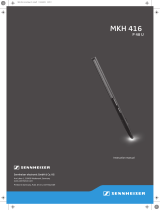
10 MKH 418 S
English
the signal totally disappears – the two channels are
now set identical – now pan channel two fully left and
channel three fully right for normal operation).
Channels two and three are controlled as a single
fader (mechanically or electrically coupled together).
The stereo width is controlled by the relative levels –
less side is a narrower image, more side is a wider
image. The displacement of the faders by 3 dB, as
shown in the diagram as an example, results in 1:1
ratio matrixing.
During matrixing, it should be taken into account that
the direction of off-axis sound signals can be
determined less and less at high frequencies due to
the increasing directivity of the shotgun microphone.
This may lead to diffused spatial effects, which can be
desirable or undesirable depending on the recording
situation. In case of doubt, the proportion of the S
signal should not be chosen too high. In some cases, it
might be necessary to reduce the treble in the S
channel on the mixing console. At low frequencies
below 300 Hz, it is very difficult to locate sounds for
physiological reasons. Since the S system of the
microphone, due to its design principle, is more
sensitive than the M system to low-frequency
interference caused for example by wind, the bass in
the S channel should be reduced if required (eg: with a
high-pass filter).
Specifications
Acoustic operating principle M: pressure gradient /
interference tube receiver
S: pressure gradient receiver
Pick-up pattern M: super-cardioid/lobar
S: figure-of-eight
Sensitivity at 1000 Hz M: 25 mV/Pa (-32 dBV)
S: 10 mV/Pa (-40 dBV)
Frequency response 40 - 20,000 Hz
Max. SPL 130 dB SPL (63 Pa)
Max. output voltage 1.5 V
Equivalent noise level M: 14 dB-A / 26 dB-CCIR
S: 22 dB-A / 34 dB-CCIR
Output impedance at 1000 Hz < 25 Ω
Min. load impedance 1 kΩ
Power supply P48: 48 ± 4 V / 2 x 2.3 mA
Connector 5-pin XLR, male
Dimensions Ø 19 mm x 280 mm
Weight 220 g
Operating temperature range -20 to +60 °C
Humidity range < 95 % relative humidity







